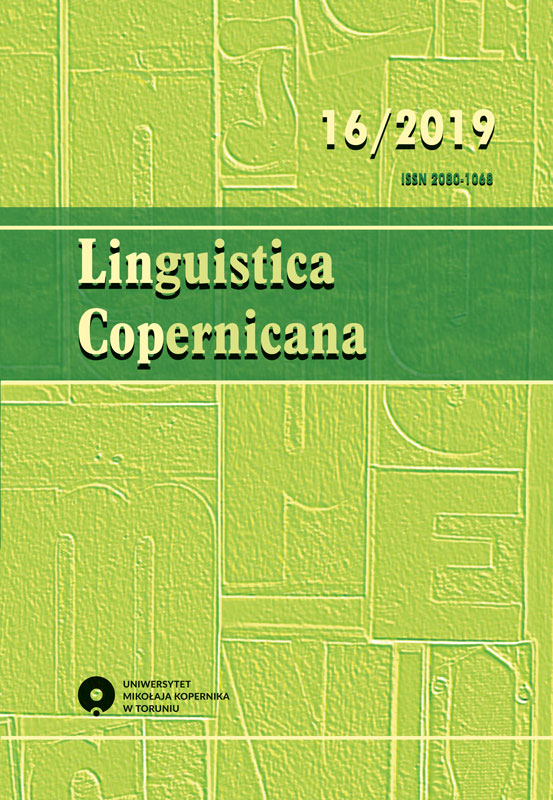Towards phrasal attachment of European Portuguese proclitics. A corpus-based inquiry into diachronic phonology-syntax interface
DOI:
https://doi.org/10.12775/LinCop.2019.011Keywords
European Portuguese, allomorphy, interpolation, clitics, negation, corpusAbstract
.References
Anderson S.R., 2005, Aspects of the Theory of Clitics, Oxford: Oxford University Press.
Arteaga D., 2009, On the existence of null complementizers in Old French, In: P.J. Masullo, E. O’Rourke, C-H Huang (eds.), Romance linguistics 2007: Selected Papers from the 37th Linguistic Symposium on Romance Languages (LSRL), Pittsburgh, 15–18 March 20017, AmsterdamPhiladelphia: John Benjamins, pp. 19–36, [online:] https://doi.org/10.1075/cilt.304.03art.
Bouzouita M., Kempson R.M., 2006, Clitic Placement in Old and Modern Spanish: A Dynamic Account , In: O. Nedergaard Thomsen (ed.), Competing Models of Linguistic Change: Evolution and beyond, AmsterdamPhiladelphia: John Benjamins, pp. 253–268, [online:] https://doi.org/10.1075/cilt.279.16bou.
Bresnan J., 2001, Lexical-Functional Syntax, Oxford: Blackwell.
Castro I., 2006, Introdução à história do português, Lisboa: Edições Colibri.
Da Tos M., The Italian FINIRE-type verbs: a case of morphomic attraction, In: S. Cruschina, M. Maiden, J.-Ch. Smith (eds.), The Boundaries of Pure Morphology, Oxford: Oxford University Press, pp. 45–67.
Dalrymple M., 2001, Lexical Functional Grammar, New York: Academic Press.
Delfitto D., 2002, On the Semantics of Pronominal Clitics and some of its Consequences, Catalan Journal of Linguistics 1, pp. 41–69.
Dryer M., 1988, Universals of negative position, In: M. Hammond, E. Moravcsik, J. Wirth (eds.), Studies in Syntactic Typology, AmsterdamPhiladelphia: John Benjamins, pp. 93–124, [online:] https://doi.org/10.1075/tsl.17.10dry.
Duarte I., Matos G., 2000, Romance Clitics and the Minimalist Program, In: J. Costa (ed.), Portuguese Syntax. New Comparative Studies, Oxford: Oxford University Press, pp. 116–142.
Fiéis M.A., 2001, Interpolação em Português Medieval como Adjunção a XP, In: Actas do XVI Encontro Nacional da Associação Portuguesa de Linguística, Lisboa, Colibri-APL, pp. 197–211.
Gerlach B., 2002, Clitics between syntax and lexicon, AmsterdamPhiladelphia. John Benjamins.
Heap D., Oliviéri M., Palasis K., 2017, Clitic pronouns, In: A. Dufter, E. Stark (eds.), Manual of Romance Morphosyntax and Syntax, BerlinBoston: De Gruyter, pp. 183–229, [online:] https://doi.org/10.1515/9783110377088-005.
Hinzelin M-O., 2010, L’interpolation dans les langues romanes: aspects diachroniques, In: M. Iliescu, H. Siller-Runggaldier, P. Danler (eds.), Actes du XXVe Congrès International de Linguistique et Philologie Romanes. Innsbruck, 3–8 septembre 2007, t. II, Tübingen: Niemeyer, pp. 331–339.
Labelle M., 2001, Trente ans de psycholinguistique, Revue québécoise de linguistique 30(1), pp. 155–176.
Levelt W.J., 1989, Speaking: from intention to articulation, Cambridge, Mass.: MIT Press.
Luís A. 2014, On clitic attachment in Ibero-Romance. Evidence from Portuguese and Spanish, In: P. Amaral, A.M. Carvalho (eds.), Portuguese-Spanish Interfaces: Diachrony, synchrony and contact, AmsterdamPhiladelphia: John Benjamins, pp. 203–235.
Luís A., Otoguro R., 2011, Inflectional Morphology and Syntax in Correspondence: Evidence from European Portuguese, In: A. Galani, G. Hicks, G. Tsoualas (eds.), AmsterdamPhiladelphia: John Benjamins, pp. 97–136, [online:] https://doi.org/10.1075/la.178.07luf.
Luís A., Kaiser G., 2016, Clitic Pronouns: Phonology, Morphology, and Syntax, In: L.W. Wetzels, J. Costa, S. Menuzzi (eds.), The Handbook of Portuguese Linguistics, West Sussex: John Wiley & Sons, Inc, pp. 471–486.
Magro C., 2010, When corpus analysis refutes common beliefs: The case of interpolation in European Portuguese dialects, Corpus 9, pp. 115–135.
Martins A.M., 2000, A Minimalist Approach to Clitic Climbing, In: J. Costa (ed.), Portuguese Syntax. New Comparative Studies, Oxford: Oxford University Press, pp. 169–190.
Martins A.M., 2014, Syntactic Change in Portuguese and Spanish. Divergent and parallel patterns of linguistic splitting, In: P. Amaral, A.M. Carvalho (eds.), Portuguese-Spanish Interfaces: Diachrony, synchrony and contact, AmsterdamPhiladelphia: John Benjamins, pp. 35–64.
Martins A.M., 2016a, Introdução: O português numa perspetiva diacrónica e comparativa, In: A.M. Martins, E. Carrilho (eds.), Manual de linguística portuguesa, BerlinBoston: De Gruyter, pp. 1–40, [online:] https://doi.org/10.1515/9783110368840-003.
Martins A.M., 2016b, A colocação dos pronomes clíticos em sincronia e diacronia, In: A.M. Martins, E. Carrilho (eds.), Manual de linguística portuguesa, Berlin–Boston: De Gruyter, pp. 410–430, [online:] https://doi.org/10.1515/9783110368840-017.
Matos G., 2003, Aspectos sintáticos da negação, In: M.H.M. Mateus, A.M. Brito, I. Duarte, I.H. Faria (eds.), Gramática da Língua Portuguesa (6.a edição), Lisboa: Caminho, pp. 767–793.
Miller Ph., Monachesi P., 2003, Les pronoms clitiques dans les langues romanes, In: D. Godard, A. Abeillé (eds.), Les langues romanes, problèmes de la phrase simple, Paris: CNRS, pp. 53–106.
Piel J.-M., 1989, A flexão verbal do português (Estudo de morfologia histórica), In: J.-M. Piel (eds.), Estudos de linguística Galego-Portuguesa, Lisboa: Imprensa Nacional-Casa de Moeda, pp. 213–244.
Raposo E., 2000, Clitic Pronouns and Verb Movement, In: J. Costa (ed.), Portuguese Syntax. New Comparative Studies, Oxford: Oxford University Press, pp. 266–297.
Sánchez López C., 2017, Coordination and correlatives, In: A. Dufter, E. Stark (eds.), Manual of Romance Morphosyntax and Syntax, BerlinBoston: De Gruyter, pp. 647–688 [online:] https://doi.org/10.1515/9783110377088-018.
Sánchez-Rei X.M., 1999, Repercusións gramaticais do uso da interpolación pronominal en galego, Cadernos de Lingua 19, pp. 85–110.
Spencer A., Luís, A., 2012, Clitics. An Introduction. Cambridge: Cambridge University Press.
Thornton A., 2011, Overabundance (Multiple Forms Realizing the Same Cell): A Non-Canonical Phenomenon in Italian Verb Morphology, In: M. Maiden, J.-Ch. Smith, M. Goldbach, M.-O. Hinzelin (eds.), Morphological Autonomy. Perspectives From Romance Inflectional Morphology, Oxford: Oxford University Press, pp. 358–381.
Vigário M., 2003, The Prosodic Word in European Portuguese, Berlin–New York: De Gruyter.
Waltereit R., 2012, Reflexive Marking in the History of French, Amsterdam–Philadelphia: John Benjamins.
Zanuttini R., 2001, Sentential Negation, In: M. Baltin, Ch. Collins (eds.), The handbook of contemporary syntactic theory, Oxford–Malden: Blackwell, pp. 511–535.
Zwicky A.M., Pullum, G., 1983, Cliticization vs. Inflection. English n’t. Language 59(3), pp. 502–513.
Downloads
Published
How to Cite
Issue
Section
Stats
Number of views and downloads: 558
Number of citations: 0



